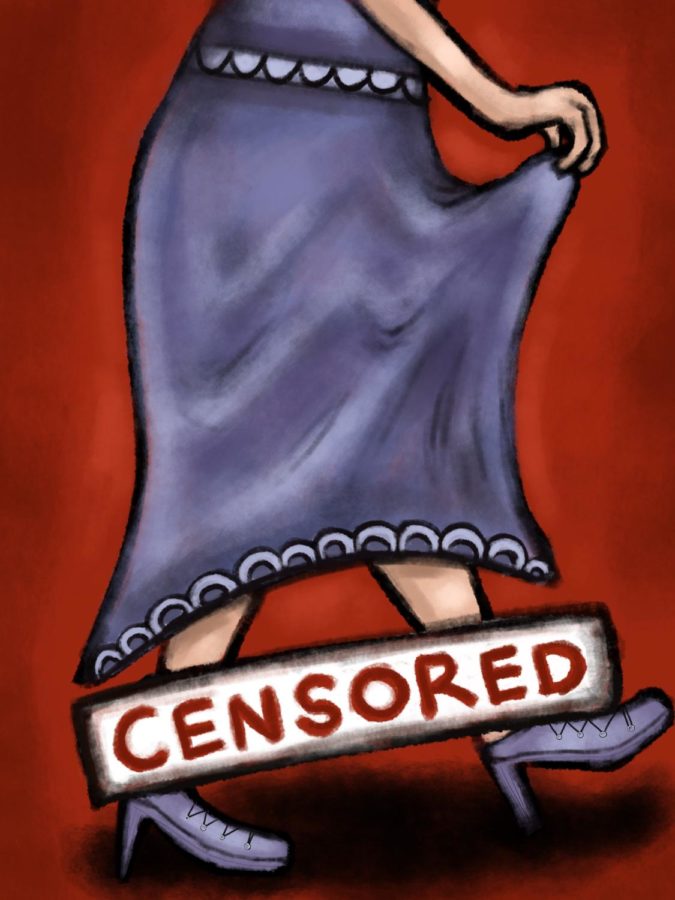Dress Codes Bolster the Taboos of the Female Body
In the 1890s, society deemed women’s ankles inappropriate. Today, hundreds of years later, dress codes only perpetuate lingering taboos of the female body. Staff illustration: Tatum Herrin.
February 1, 2022
As early as 300,000 years ago, Homo sapiens roamed the earth wearing hardly anything. We spent our days hunting and gathering with one thing in mind: survival. Clothing was a means to an end, nothing more than protection from the cold. Somewhere along the line, we learned our bodies were something to be covered.
As American society grows more progressive, the range of socially acceptable clothing expands. According to a Marie Claire article, standards for women’s clothing have grown more relaxed. However, strict dress codes are still prominent in about 55.5% of schools across America, according to the Atlanta Journal-Constitution. Although Menlo does not have an official dress code, several female students have been told by faculty to “cover-up” this year. These instances raise the question: what’s appropriate for a girl to wear to school?
According to the New York Times, dress codes are often put into place to prevent distractions. The subtext of “distractions” is clear: the exposure of our bodies is encouraging sexual attraction within our peers or faculty, which may inconvenience them or endanger us. However, these arguments often fail to address what it is about a child’s body simply existing that encourages sexual attraction.
BBC News conducted an experiment to explore why we are so ashamed of being naked. The study found that, as time passed, those who were once uncomfortable being naked in front of others they were not intimate with grew more, if not completely, comfortable without clothing as they spent more time nude.
The results of this study suggest that our discomfort with our bodies is a learned — and therefore an impermanent phenomenon. From what we know about social norms throughout human history, the inherent sexuality of our body parts is something of our unconscious creation as a society.
It goes without saying that attending school nude is beyond inappropriate. However, in theory, there shouldn’t be a danger in doing so. A body existing does not warrant sexual attraction. A female’s chest does not warrant sexual attention, just as the chest of a male fails to do so. It only warrants distraction because it’s out of the norm.
Despite mounting evidence that the sexualization of the human figure is psychological, it would be naive to deny a potential biological component. While biologists have yet to authoritatively prove why heterosexual men are attracted to the female breasts and butt, a multitude of different theories exist. What many studies can agree on, however, is that the phenomenon is no doubt an intersection between culture and sex.
According to ScienceDirect, several studies suggest that the physical attractiveness of a woman directly correlates to the waist-to-hip ratio (WHR) of a woman. For reference, a lower WHR indicates a high estrogen/testosterone ratio, which favors reproductive function. While this study gives meaningful insight into the biological reasons men may seek out partners with pronounced breasts and butts, the study fails to explain the taboos of these body parts.
Author ED Cash explains in his book Body Images: Development, Deviance, and Change that the attraction to breasts varies across cultures, with some preferring small, pointed breasts, others larger breasts. In some cultures, breasts are not seen as secondary sexual characteristics at all. The bottom line: the sexuality of a woman’s chest is subjective.
A project presented by the faculty of San Diego State University (SDSU) called “Cultural Perceptions of Women’s Breasts” explores breast fetishism. According to this project, the term breast fetishism is used “within ethnographic and feminist contexts to describe a society that has normalized breasts as sexual objects in part of its culture.”
The project references the work of feminist scholar Elizabeth Gould Davis. Davis claims that breast fetishism dates back to the Neolithic era within the city Catal Huyuk. Archeologists discovered shrines ornamented with breasts detached from a body. Davis believes the women of Catal Huyuk celebrated breasts almost as their own entity, as a symbol of both femininity and motherhood. She believes that, after the patriarchal revolution of Huyuk society, men appropriated the worship of breasts in a self-serving nature. As a result, these previously celebrated organs acquired a more erotic significance.
Across the globe, the cultural connotations of the breast fluctuate dramatically. As mentioned in SDSU’s project, some African cultures, such as the San of Namibia and Masaai of East Africa, do not consider exposed breasts nudity, but rather a celebration of the female body. In other African cultures, prominent practices of breast-binding prove breasts are seen as a menace. This vast range demonstrates the limitations of biology in the cultural significance of breasts.
Breast fetishization is deeply ingrained into American pop culture. Yet, we simultaneously consider exposed breasts immodest. The fixation on modesty in America can be traced back to those who founded this country. Many of the British colonists that eventually formed the United States fled Europe in the face of religious persecution, determined to pursue their religious convictions. Protestant revivals throughout the country’s history have cultivated the modern, Christian-dominated society we live in. The Bible demonstrates Christian ideals of modesty, claiming women should dress with modesty and self-control, as stated in verse 1 Timothy 2:29.
Because exclusively female body parts are considered sexual, girls are disproportionately targeted by a dress code. Upholding overly-fetishized views of the female form in our school is counterproductive. As a culture, we are greatly distant from normalizing the idea of covering whatever we wish at any given time. Even then, teachers reprimanding a girl for exposing cleavage in school further perpetuates inherent sexuality or wrongfulness about female bodies, an elusive notion of sexuality we construct ourselves. Rather, teachers should instruct students to respect each other’s expressions.
We fear the things that stray from the norm. However, norms are often a link to toxicity, to outdated and oppressive ways of thinking. Our school should not propagate that a women’s body is inherently sexual, regardless of how deeply the concept is ingrained in our society.
At Menlo, a dress code should only restrict content shown on clothing, such as offensive language. “Modesty” should not be monitored by the school. Dress coding a student for exposure only causes humiliation and discomfort for the student. It may be true that when a woman exposes her body, especially a minor, she can put herself at risk. However, students deserve the safety and respect within our community to wear what they choose freely, without fear of being objectified or shamed by the faculty they trust. Men and women alike should be held accountable despite what our predicted biological tendencies are, and should be making an active effort to adjust our perspective of the female body and standards of “modesty.”




Zaria Carey • Feb 21, 2024 at 5:47 pm
This is absolutely amazing and I am going to mention some of these points when I talk to the superintendent of my district about making changes to our dress code.